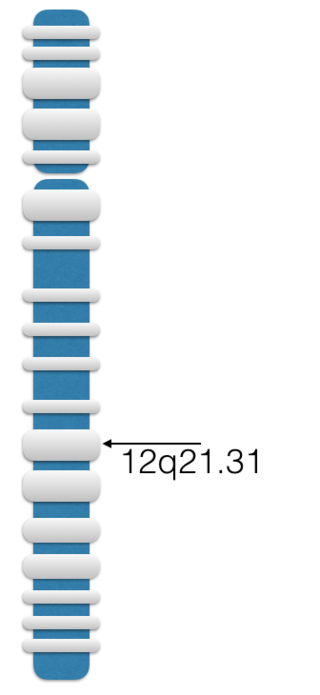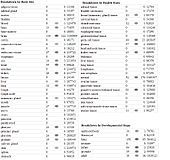
SLITRK1 is a human gene that codes for a transmembrane and signalling protein that is part of the SLITRK gene family, which is responsible for synapse regulation and presynaptic differentiation in the brain. Expression of the gene has been linked to early formation of excitatory synapses through binding with receptor tyrosine phosphatase PTP (LAR-RPTP). Various studies over the years have linked mutations in the gene to conditions on the OCD spectrum, Tourette syndrome and trichotillomania, however the mutations in the genome itself vary greatly between individuals, with most mutations observed being hard to find in repeat studies.

A leucine-rich repeat (LRR) is a protein structural motif that forms an α/β horseshoe fold. It is composed of repeating 20–30 amino acid stretches that are unusually rich in the hydrophobic amino acid leucine. These tandem repeats commonly fold together to form a solenoid protein domain, termed leucine-rich repeat domain. Typically, each repeat unit has beta strand-turn-alpha helix structure, and the assembled domain, composed of many such repeats, has a horseshoe shape with an interior parallel beta sheet and an exterior array of helices. One face of the beta sheet and one side of the helix array are exposed to solvent and are therefore dominated by hydrophilic residues. The region between the helices and sheets is the protein's hydrophobic core and is tightly sterically packed with leucine residues.

Leucine-rich repeat-containing G-protein coupled receptor 5 (LGR5) also known as G-protein coupled receptor 49 (GPR49) or G-protein coupled receptor 67 (GPR67) is a protein that in humans is encoded by the LGR5 gene. It is a member of GPCR class A receptor proteins. R-spondin proteins are the biological ligands of LGR5. LGR5 is expressed across a diverse range of tissue such as in the muscle, placenta, spinal cord and brain and particularly as a biomarker of adult stem cells in certain tissues.

Leucine rich repeat and Immunoglobin-like domain-containing protein 1 also known as LINGO-1 is a protein which is encoded by the LINGO1 gene in humans. It belongs to the family of leucine-rich repeat proteins which are known for playing key roles in the biology of the central nervous system. LINGO-1 is a functional component of the Nogo receptor also known as the reticulon 4 receptor.

SLIT and NTRK-like protein 5 is a protein that in humans is encoded by the SLITRK5 gene.

Transmembrane protein 8B is a protein that in humans is encoded by the TMEM8B gene. It encodes for a transmembrane protein that is 338 amino acids long, and is located on human chromosome 9. Aliases associated with this gene include C9orf127, NAG-5, and NGX61.
Slit is a family of secreted extracellular matrix proteins which play an important signalling role in the neural development of most bilaterians. While lower animal species, including insects and nematode worms, possess a single Slit gene, humans, mice and other vertebrates possess three Slit homologs: Slit1, Slit2 and Slit3. Human Slits have been shown to be involved in certain pathological conditions, such as cancer and inflammation.

Leucine rich repeat containing 57, also known as LRRC57 is a protein encoded in humans by the LRRC57 gene.

MORN1 containing repeat 1, also known as Morn1, is a protein that in humans is encoded by the MORN1 gene.

Leucine rich repeat containing 40 (LRRC40) is a protein that in humans is encoded by the LRRC40 gene.

Family with Sequence Similarity 203, Member B (FAM203B) is a protein encoded by the FAM203B gene (8q24.3) in humans. While FAM203B is only found in humans and possibly non-human primates, its paralog, FAM203A, is highly conserved. The FAM203B protein contains two conserved domains of unknown function, DUF383 and DUF384, and no transmembrane domains. This protein has no known function yet, although the homolog of FAM203A in Caenorhabditis elegans (Y54H5A.2) is thought to help regulate the actin cytoskeleton.
The GPIb-IX-V complex is a profuse membrane receptor complex originating in megakaryocytes and exclusively functional on the surface of platelets. It primarily functions to mediate the first critical step in platelet adhesion, by facilitating binding to von Willebrand factor (VWF) on damaged sub-endothelium under conditions of high fluid shear stress. Although the primary ligand for the GPIb-V-IX receptor is VWF, it can also bind to a number of other ligands in the circulation such as thrombin, P-selectin, factor XI, factor XII, high molecular weight kininogen as well as bacteria. GPIb-IX-V offers a critical role in thrombosis, metastasis, and the life cycle of platelets, and is implicated in a number of thrombotic pathological processes such as stroke or myocardial infarction.

KIAA1841 is a gene in humans that encodes a protein known as KIAA1841. KIAA1841 is targeted for the nucleus and it predicted to play a role in regulating transcription.

EVI5L is a protein that in humans is encoded by the EVI5L gene. EVI5L is a member of the Ras superfamily of monomeric guanine nucleotide-binding (G) proteins, and functions as a GTPase-activating protein (GAP) with a broad specificity. Measurement of in vitro Rab-GAP activity has shown that EVI5L has significant Rab2A- and Rab10-GAP activity.

Leucine rich repeat containing 24 is a protein that, in humans, is encoded by the LRRC24 gene. The protein is represented by the official symbol LRRC24, and is alternatively known as LRRC14OS. The function of LRRC24 is currently unknown. It is a member of the leucine-rich repeat (LRR) superfamily of proteins.

Leucine-rich repeats and IQ motif containing 1 is a protein that in humans is encoded by the LRRIQ1 gene. The protein is likely a nuclear encoding mitochondrial protein and is found in all Metazoans.

LRRIQ3, which is also known as LRRC44, is a protein that in humans is encoded by the LRRIQ3 gene. It is predominantly expressed in the testes, and is linked to a number of diseases.

Chromosome 9 open reading frame 50 is a protein that in humans is encoded by the C9orf50 gene. C9orf50 has one other known alias, FLJ35803. In humans the gene coding sequence is 10,051 base pairs long, transcribing an mRNA of 1,624 bases that encodes a 431 amino acid protein.

KRBA1 is a protein that in humans is encoded by the KRBA1 gene. It is located on the plus strand of chromosome 7 from 149,411,872 to 149,431,664. It is also commonly known under two other aliases: KIAA1862 and KRAB A Domain Containing 1 gene and encodes the KRBA1 protein in humans. The KRBA family of genes is understood to encode different transcriptional repressor proteins

Chromosome 13 Open Reading Frame 46 is a protein which in humans is encoded by the C13orf46 gene. In humans, C13orf46 is ubiquitously expressed at low levels in tissues, including the lungs, stomach, prostate, spleen, and thymus. This gene encodes eight alternatively spliced mRNA transcript, which produce five different protein isoforms.




















